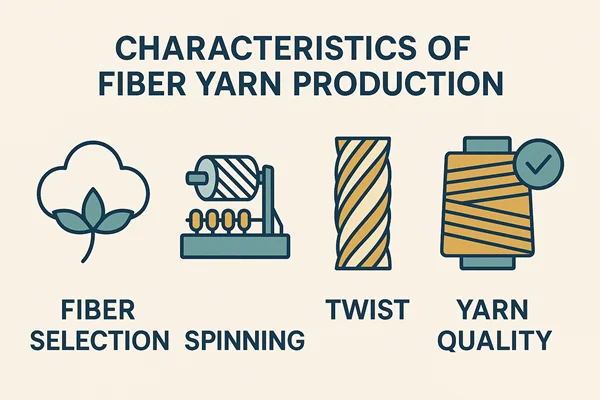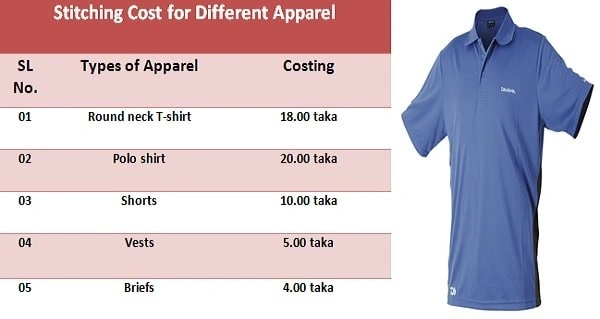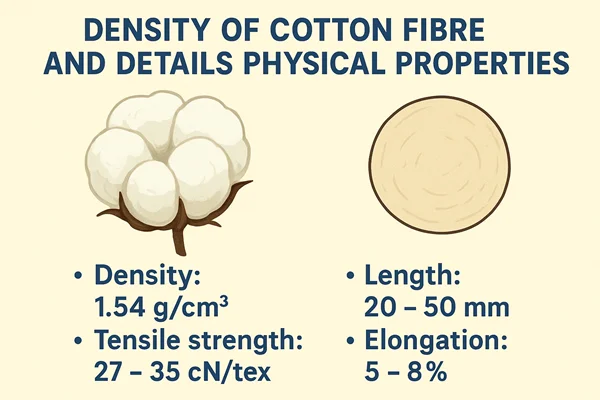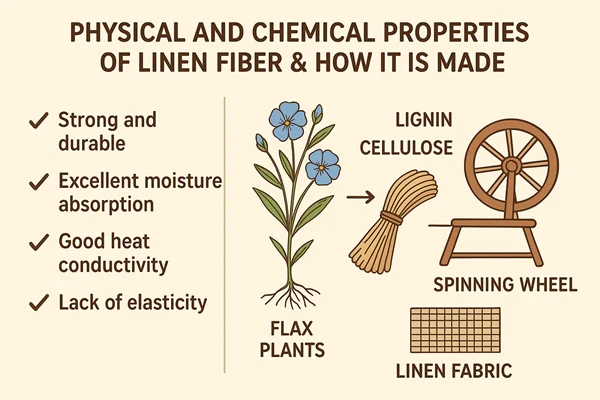List of Important Characteristics of Fiber Yarn Production
The production of fiber yarn, also known as spinning or the yarn manufacturing process. It is a complex process with several critical characteristics that determine the quality, cost, and final application of the yarn. These characteristics can be broadly divided into three categories: Fiber Properties, like fineness, length, Process Parameters, and Final Yarn Properties. This article is all about the List of Important Characteristics of Fiber Yarn Production.

List of 12 Important Characteristics of Fiber Yarn Production
1) Fiber Fineness
How many fibers in the yarn cross-section would be a determining factor? The effect of fiber fineness of yarns;
– Fine grain is less than the bending.
– Production rate is faster in thinner fibers.
– Thin fibers are much brighter.
– Composed of thin fibers of the fabric is more than casting.
– Thin fibers are less irregular.
– Life would be viewed as the cross-section strength is increased further.
– Deflection limits can vary.
2) Fiber length
– Production of the impact.
– Yarn hairiness is less than the long fibers.
– Long-life products increased in brightness.
– Yarn evenness is less in the long fibers.
– Yarn strength is more than long fibers.
– Short-fiber spinning removes the problem in flight.
– Short fibers can cause smooth statelessness.
3) For fiber strength and longer features
– A minimum strength of textile fibers (6km length is cut off under their own weight) is six rkm.
Factors affecting strength;
– Temperature decreases with increasing strength.
– Elongation increases when wet.
– Cotton and linen, except that wet strength is reduced.
– Chemical components and structure depend.
Type strain
– Permanent Elongation: Force to rise from its original state after
– Elastic Elongation: Force up to its original state after the endless
– Elongation at break: break, until that space is the total.
4) Hardness
– A textile fiber is the resistance to bending.
– Hairy causes of discrimination.
– Can not adapt during bending.
– Short and thick fibers are more rigid.
5) Moisture Absorption
The factors affecting moisture absorption;
– Of the person’s comfort
– Tear down the amount before the next draw
– Tear down the speed before the next dry
– The formation of static electricity
6) Wear Resistance of
– Abrasion-resistant polyamide fibers and polyesters highest.
– Cotton and wool are the best for resistance.
– Fabric and yarn yapısıda is important.
7) Resistance to BEAM
– Textile mamülünün’ wrinkle dry, wet, and temperature can vary depending on factors.
– Water cross-links weaken, so wrinkles are more noticeable when wet.
8) Friction
– Life to slide over each other are the factors that prevent separation.
– Slim and long contact with the surface of fibers is more robust than it.
– Sewing threads are slightly different in the case. Oiled yarn.
– How often does touching fabric is so much friction, and the fabric is so strong.
9) Density
– Life in molecular weight and density of fibers in the frequency varies.
– The same number a low-density fibers, high-volume density is more than one thread.
– Fabric should be taken into account in the design is an important feature.
10) Brightness
– Thicker than thin fibers appear brighter.
– Diameter is brighter than the fibers properly.
– With a circular cross section are brighter than fibers, silk is triangular and slightly brighter.
– Filament yarns, yarns Stapel is brighter.
11) Thermal Fix
– Seamless polyamide products, whether through the mold, are a heat-forming process.
– Widely used in our socks.
12) Flame Repellency Of
– Flame is sensitive.
– Varies depending on the type of fiber.
Process Parameters & Technology
The methods and machinery used to transform fibers into yarn are critical.
- Spinning System:
- Ring Spinning: The most common and versatile system. Produces a strong, fine, and high-quality yarn with a smooth handle. It is, however, slower and more expensive due to limitations on spindle speed.
- Open-End (Rotor) Spinning: A faster and more productive system. The yarn is coarser, hairier, and bulkier with lower strength. Ideal for denim, towels, and heavy-duty fabrics.
- Air-Jet Spinning: Very high-speed process. Produces a smooth, uniform yarn but with lower strength and a harsher feel. Excellent for blending synthetic fibers and making shirting fabrics.
- Compact Spinning: A modification of ring spinning that condenses the fiber strand before twisting. This results in a superior yarn with very low hairiness, high strength, and excellent smoothness, reducing pilling.
- Level of Twist (Twists Per Inch – TPI):
- High Twist: Creates a harder, stronger yarn with a livelier feel. Used for crepe fabrics, voiles, and sewing thread. Too many twists can cause snarling and kinking.
- Low Twist: Produces a softer, bulkier, and more absorbent yarn, but it is weaker. Used for sweaters and soft, fuzzy fabrics.
- Yarn Count (or Yarn Number):
- This is a numerical expression that defines the fineness or coarseness of the yarn. There are two main systems:
- Direct System (e.g., Denier, Tex): Weight per unit length. A lower number means a finer yarn.
- Indirect System (e.g., Cotton Count – Ne, Worsted Count – Nm): Length per unit weight. A higher number means a finer yarn.
- Controlling the yarn count is fundamental to meeting product specifications.
- This is a numerical expression that defines the fineness or coarseness of the yarn. There are two main systems:
- Drafting and Doubling:
- Drafting: Attenuating the fiber strand to the desired fineness. It must be controlled to maintain fiber alignment and uniformity.
- Doubling: Combining several slivers or rovings to blend fibers and average out irregularities, significantly improving yarn evenness.
- Cleaning and Blending:
- Cleaning: Removing impurities (dirt, seeds, leaves in cotton; vegetable matter in wool) is essential for process efficiency and yarn quality.
- Blending: Mixing different fiber types (e.g., polyester/cotton) or different lots of the same fiber to achieve consistent color, reduce cost, or create a yarn with specific performance characteristics.
3. Final Yarn Characteristics (The Outcome)
These are the measurable properties of the finished yarn that determine its suitability for the end-use.
- Yarn Evenness / Uniformity: The consistency of the yarn’s linear density along its length. Uneven yarns lead to fabric defects like streaks and barre.
- Strength and Elongation: The force required to break the yarn and how much it stretches before breaking. This is critical for withstanding the stresses of weaving, knitting, and garment use.
- Hairiness: The number and length of protruding fibers from the main yarn body. High hairiness can cause pilling, fogginess in weaving, and reduced clarity in printed fabrics.
- Imperfections: The number of thick places, thin places, and neps (small knots of tangled fibers) in the yarn. Modern electronic yarn clearers are used to monitor and remove these.
- Appearance and Luster: The visual quality, which is influenced by fiber type, twist, and spinning system. Mercerization of cotton, for example, enhances its luster.
Summary
The production of fiber yarn is a balancing act where Characteristics of Fiber Yarn Production dictate the possible outcomes, process parameters are the levers used to achieve them, and the final yarn characteristics are the proof of success. Understanding the interplay between these characteristics is essential for a spinner to produce a yarn that is cost-effective, efficient to manufacture, and perfectly suited for its intended fabric and end-product.



